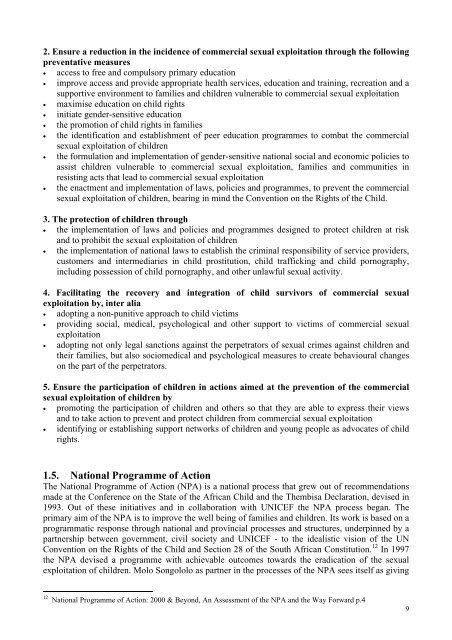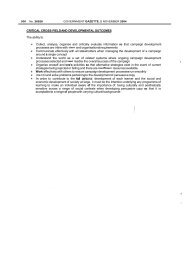The trafficking of children for purposes of sexual exploitation
The trafficking of children for purposes of sexual exploitation
The trafficking of children for purposes of sexual exploitation
You also want an ePaper? Increase the reach of your titles
YUMPU automatically turns print PDFs into web optimized ePapers that Google loves.
2. Ensure a reduction in the incidence <strong>of</strong> commercial <strong>sexual</strong> <strong>exploitation</strong> through the following<br />
preventative measures<br />
• access to free and compulsory primary education<br />
• improve access and provide appropriate health services, education and training, recreation and a<br />
supportive environment to families and <strong>children</strong> vulnerable to commercial <strong>sexual</strong> <strong>exploitation</strong><br />
• maximise education on child rights<br />
• initiate gender-sensitive education<br />
• the promotion <strong>of</strong> child rights in families<br />
• the identification and establishment <strong>of</strong> peer education programmes to combat the commercial<br />
<strong>sexual</strong> <strong>exploitation</strong> <strong>of</strong> <strong>children</strong><br />
• the <strong>for</strong>mulation and implementation <strong>of</strong> gender-sensitive national social and economic policies to<br />
assist <strong>children</strong> vulnerable to commercial <strong>sexual</strong> <strong>exploitation</strong>, families and communities in<br />
resisting acts that lead to commercial <strong>sexual</strong> <strong>exploitation</strong><br />
• the enactment and implementation <strong>of</strong> laws, policies and programmes, to prevent the commercial<br />
<strong>sexual</strong> <strong>exploitation</strong> <strong>of</strong> <strong>children</strong>, bearing in mind the Convention on the Rights <strong>of</strong> the Child.<br />
3. <strong>The</strong> protection <strong>of</strong> <strong>children</strong> through<br />
• the implementation <strong>of</strong> laws and policies and programmes designed to protect <strong>children</strong> at risk<br />
and to prohibit the <strong>sexual</strong> <strong>exploitation</strong> <strong>of</strong> <strong>children</strong><br />
• the implementation <strong>of</strong> national laws to establish the criminal responsibility <strong>of</strong> service providers,<br />
customers and intermediaries in child prostitution, child <strong>trafficking</strong> and child pornography,<br />
including possession <strong>of</strong> child pornography, and other unlawful <strong>sexual</strong> activity.<br />
4. Facilitating the recovery and integration <strong>of</strong> child survivors <strong>of</strong> commercial <strong>sexual</strong><br />
<strong>exploitation</strong> by, inter alia<br />
• adopting a non-punitive approach to child victims<br />
• providing social, medical, psychological and other support to victims <strong>of</strong> commercial <strong>sexual</strong><br />
<strong>exploitation</strong><br />
• adopting not only legal sanctions against the perpetrators <strong>of</strong> <strong>sexual</strong> crimes against <strong>children</strong> and<br />
their families, but also sociomedical and psychological measures to create behavioural changes<br />
on the part <strong>of</strong> the perpetrators.<br />
5. Ensure the participation <strong>of</strong> <strong>children</strong> in actions aimed at the prevention <strong>of</strong> the commercial<br />
<strong>sexual</strong> <strong>exploitation</strong> <strong>of</strong> <strong>children</strong> by<br />
• promoting the participation <strong>of</strong> <strong>children</strong> and others so that they are able to express their views<br />
and to take action to prevent and protect <strong>children</strong> from commercial <strong>sexual</strong> <strong>exploitation</strong><br />
• identifying or establishing support networks <strong>of</strong> <strong>children</strong> and young people as advocates <strong>of</strong> child<br />
rights.<br />
1.5. National Programme <strong>of</strong> Action<br />
<strong>The</strong> National Programme <strong>of</strong> Action (NPA) is a national process that grew out <strong>of</strong> recommendations<br />
made at the Conference on the State <strong>of</strong> the African Child and the <strong>The</strong>mbisa Declaration, devised in<br />
1993. Out <strong>of</strong> these initiatives and in collaboration with UNICEF the NPA process began. <strong>The</strong><br />
primary aim <strong>of</strong> the NPA is to improve the well being <strong>of</strong> families and <strong>children</strong>. Its work is based on a<br />
programmatic response through national and provincial processes and structures, underpinned by a<br />
partnership between government, civil society and UNICEF - to the idealistic vision <strong>of</strong> the UN<br />
Convention on the Rights <strong>of</strong> the Child and Section 28 <strong>of</strong> the South African Constitution. 12 In 1997<br />
the NPA devised a programme with achievable outcomes towards the eradication <strong>of</strong> the <strong>sexual</strong><br />
<strong>exploitation</strong> <strong>of</strong> <strong>children</strong>. Molo Songololo as partner in the processes <strong>of</strong> the NPA sees itself as giving<br />
12 National Programme <strong>of</strong> Action: 2000 & Beyond, An Assessment <strong>of</strong> the NPA and the Way Forward p.4<br />
9
















